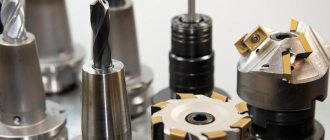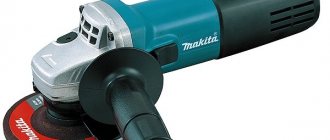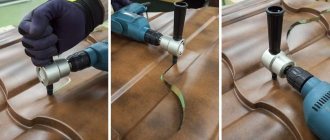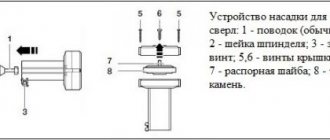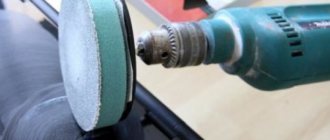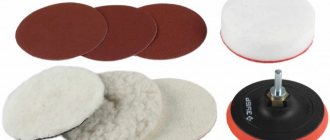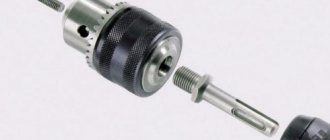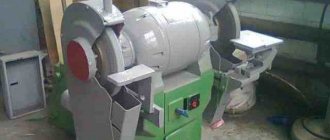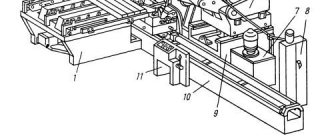A drill is one of the most versatile tools on the farm. With its help, you can even carry out polishing and grinding work by choosing a special attachment. We will learn about the advantages and disadvantages of using attachments instead of the whole tool, about their types and areas of application. Let's figure out which drill attachment for grinding is suitable for which work, what types exist and what materials are used.
Attachments for small work Source main-cdn.goods.ru
Features of using grinding attachments
The drill is often used when performing construction and repair work. Having different attachments for the drill, it can not only drill, but also grind, polish and clean surfaces.
Grinding attachments are used in different cases:
- For polishing metal and wood, can be used on painted or varnished surfaces;
- Grinding small metal products or those located in difficult places;
- Treatment of primed surfaces;
- Cleaning from rust, old varnish or paint;
- Cleaning hard-to-reach places from defects;
- Polishing glass and grinding its edges.
Different attachments are used for each purpose, but in general, purchasing them will cost less than purchasing an additional grinder.
“Plate” Source instrument-club.ru
Using sanding attachments on a drill has its pros and cons. The first include:
- Possibility not to buy additional equipment. If you only need to clean the surface once during repairs, it is better to use an existing drill rather than buying a device that will be useless in the future.
- Low price of the nozzles themselves. You can buy many types to work with different materials.
- A large selection of attachments makes it easy to choose the right one for a specific job. Diversity allows you to replace several tools at once.
There is only one drawback: in comparison with professional tools, a drill with an attachment has low speed and productivity. It will not cope with a huge amount of work, but will perform well during repairs or construction in a private house or garage.
“Bowl” Source mozmarket.ru
See also: Catalog of companies that specialize in finishing materials and related work
Useful tips when working
For each type of material and method of its processing, there is its own recommended grinding speed, which directly depends on the rotation speed of the power tool motor.
In addition, an abrasive tool can only work effectively at standard speeds, which depend on its type and the type of material being processed. Therefore, when working with grinding attachments, it is recommended to use a drill with variable speed control. This will allow, without delving into the intricacies of grinding modes, to simply select the required rotation speed for a particular case. Many grinding attachments are designed quite simply, and for one-time jobs you can make them yourself. This is especially true for soft and drum attachments, as well as various plates with glued sandpapers. It is also easy to make a device for fixing the drill in a horizontal position, with which it can be used as a grinding or sharpening machine. The video below shows a selection of methods for making such homemade products.
Foam rubber is usually used as a soft pad in sanding pads. But this is a very soft and short-lived material. What can be used instead of foam rubber? Are there elastic materials with similar characteristics that are less susceptible to wear? If you know the answer to this question, please share the information in the comments in this article.
Types of nozzles
Attachments for drills for grinding are made according to the same principle as replaceable blocks for polishing machines. They differ in the type of fastening: in special machines a thread is used, on a drill the fastening is made using a pin.
There are several types. The choice of a specific one depends on the material and the required operation.
Plate
Round nozzle with sandpaper. The latter varies in graininess and hardness. When working, the drill must go strictly at right angles to the surface. When tilted, defects and damage will appear on the tree. For convenience, some “plates” adjust the angle themselves.
“Disk” Source: vashinstrument.com
Cup
The cup attachment for a sanding drill looks like a brush with long metal bristles. The shape resembles an inverted cup made of plastic or metal. There are also “bowls” with soft filling.
It performed well when working with wood. Metallic fibers release the fibers of the material, which well emphasizes the wood structure. The result is a natural look.
Types of grinding wheels
Shapes of grinding wheels
To determine the types of grinding wheels, you need to familiarize yourself with GOST 2424-83. It indicates the area of purpose, material of manufacture and requirements for the technical parameters of this type of tool. But the operating conditions are the determining factor.
Currently, the following types of face and plane wheels with appropriate markings and designations can be used to perform grinding work:
- grinding for metal. Used for processing welded joints. After installation on the drill, the end part processes workpieces and parts;
- diamond Designed for final grinding of the workpiece surface. It should be remembered that they belong to the category of sharpening ones. Characterized by a special composition;
- fiber. Made from multi-layer vulcanized paper. Processing occurs with both the end and planar parts of the material. Designed for installation on a drill;
- petal. They consist of many petals mounted on a mounting ring. They are characterized by high adaptability to any type of workpiece surface. Flap discs effectively remove rust;
- self-hinging. Characterized by a high grain size. One part has an adhesive backing for installation on a drill. Designed for fine processing of wooden or metal surfaces.
Before choosing, you should consider the grit size of the grinding discs. The same applies to sharpening models. The larger the grain size, the more intensively material will be removed from the surface of the part during sharpening.
For metal
Diamond
Fiber
Petalaceae
Self-hinging
The diameter is also taken into account. For household machines, models with a diameter from 50 to 300 mm are used. During fine machining, specially shaped wheels can be installed.
Material used
Sanding attachments are made from different materials. You need to select them depending on the surface being treated and the work being carried out. For example, to remove rust and paint you will need a hard attachment, for polishing - a soft one.
3 types of materials are used:
- Soft. They remove primer and putty, traces of rust, and are used for polishing and removing dirt. Thanks to the soft action, the metal does not heat up or deteriorate during operation, which improves the quality of grinding.
Soft Source ebayimg.com
- Emery cloth. The most popular drill attachment for sanding wood. It varies in grain size and roughness, which allows it to be used for different types of work - from rough surface cleaning to finishing details.
- Grinding stones. These are special abrasive stones that are harder and more durable. With their help you can eliminate defects from the surface. They are usually used for preparing and leveling concrete, glass, and ceramics.
When choosing, it is important to focus not only on the material, but also on its hardness and grain size. For example, felt can be used to polish a car.
Marking of main grinding wheels
Marking of abrasive wheel
In order to choose the optimal grinding wheel model, you need to know the symbols on its surface. In this way, you can find out not only the method of its manufacture, but also the grain size, exact dimensions and configuration: flap, regular or special sharpening.
First of all, you should determine the material of manufacture and the possibility of using it as a sharpener on a machine. Data can be taken from the list described above. Then the grain size of the drill wheel is determined. In some cases, the pictogram indicates that face machining is not possible. Most often this concerns corundum discs for metal.
The next property is the hardness of the grinding wheel. Classification depending on its composition:
- F, G. Classified as very soft;
- H, I, J. Soft, designed for finishing parts;
- K, L. Products with medium softness are marked in this way;
- M, N. Medium, the most common type;
- O, P, Q. Medium hard;
- R, S. Solid;
- T, U. Very hard, used as a sharpener;
- V, W, X, Y, Z. Extremely hard.
Manufacturers rarely indicate the structure and composition of the disc on the label. First of all, this relates to the type of connection. This term indicates what composition was used to create a homogeneous mass. Currently, ceramic, bakelite and vulcanite binders can be used as a binding component.
During operation, the geometry of the oval circle or the size of the petal base may be disrupted. This is especially true for face machining of parts using a drill or machine. In this case, it is necessary to make changes according to the marking. To do this, it is recommended to use carbide tools or diamond discs.
The video shows the main types of grinding wheels:
Video description
How to sand a wooden surface is shown in the video:
When working, it is important to correctly hold the sanding attachment on a wood drill relative to the surface. For example, if the plate attachment is not positioned at a right angle, its edges will easily damage the surface. To understand the principle of operation, it is worth practicing holding the tool correctly in advance.
There are 2 options for grinding with a drill:
- The worker holds a drill in his hands and works like an ordinary tool. This is a simpler and more familiar method, but it has disadvantages. Holding a drill for a long time can be tiring. In addition, it is important to monitor its position and not tilt it. Large surfaces are sanded in this way: walls, floors, ceilings, large furniture, cars.
- The drill is fixed motionless on the table, and the object is brought to it. This method can achieve high quality grinding, but it can only be used on small objects that can be held in your hands.
Advantages and disadvantages of grinding attachments for drills
Power tool accessories have a number of strengths and weaknesses. Advantages:
- Low price.
- A wide range of products, represented by different types of abrasive materials and types of attachments.
- Ability to work with different materials.
- Cheap replacement for specialized grinding tools.
- Ability to process hard-to-reach places.
- Durable, simple fixation in the chuck.
Flaws:
- Certain types of equipment require skill in use.
- Not all attachments are convenient to use, as your hands get tired quickly.
When choosing equipment for grinding, you need to take into account the power of the drill and the presence of a speed controller.
Briefly about the main thing
A drill is a versatile tool that is easy to grind, polish and clean surfaces. To do this, just buy special attachments.
The advantages of grinding attachments include the ability to save on the purchase of unnecessary equipment and ease of use. Their disadvantage is lower speed and low productivity compared to professional tools.
Nozzles are divided into several types: cup, plate, drum and others. Each type is suitable for certain jobs, for example, hard plate attachments work well with preliminary processing of wood, softer ones - with final processing.
You can work with attachments in two ways: move a disk over the surface or attach a drill and bring the object to it. The first option is suitable for large surfaces, the second - for small parts.
Additional reference materials
Microhardness of materials
Heat resistance of materials
Grit ratio
Grit numbers according to GOST
Designation of wheel hardness Structure of abrasive
Peripheral grinding
Face grinding
Disadvantages and effectiveness of use
Owners have divided opinions about how effective the use of a sharpening attachment is. Like any other not too expensive device, the design is not without some disadvantages:
- the attachment is intended rather for straightening the cutting edges of “squat” drills;
- It is better not to sharpen absolutely “dead” edges, otherwise the wheel will not last long;
- not the most reliable fixation on the drill;
- it is almost impossible to change the sharpening angle;
- when rotating, the cartridge sometimes touches the inner surface of the adapter coupling (diameters must be matched to prevent this from happening, but it is not always possible to try it on);
- It is inconvenient to hold the drill, turn it on, while guiding the drill with the other hand (for greater comfort, if possible, you should use a bracket that allows you to fix the drill).
However, despite the shortcomings, the device found its consumer. Due to its compactness, light weight and relatively low price, the nozzle sells well. It is used in “field” conditions, in households and small workshops. According to the owners' reviews, the skill of operational sharpening is formed quite quickly.
The effectiveness of this device is assessed differently. Some people believe that the design is too weak for regular use, others - that for certain conditions the thing is simply irreplaceable. Based on the reviews that can be found, we can conclude the following - if you do not place too great demands on this device, then the attachment shows itself on the good side.
Design and principle of operation
The design is simple - a small abrasive wheel, which has a special shape, rotates in a plastic case using a drill, allowing you to create a certain sharpening angle. The body has special holes for drills, each with its own diameter (range, as a rule, from 3.5 to 10 mm). The rotation of the working part is carried out using a drill, which is connected to the nozzle through a coupling.
The guide holes for drills are made in such a way that the edge of the tool being sharpened comes into contact with the surface of the stone only in a certain position. The drill is inserted into a hole of the appropriate diameter, the drill is started, and one of the cutting edges is processed. After turning 180 degrees, the second edge is sharpened. This is repeated several times until the edges are satisfied with their quality.
The nozzle is rotated by a drill, the chuck of which has completely closed jaws. There are reviews about using the device with keyless chucks, without installing an adapter coupling. Unfortunately, the plastic coupling, even if it is firmly fixed, does not always provide reliable fastening, and the structure does not have good rigidity.
